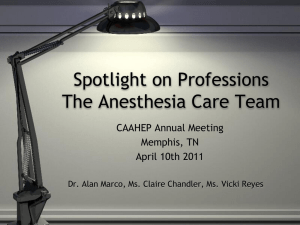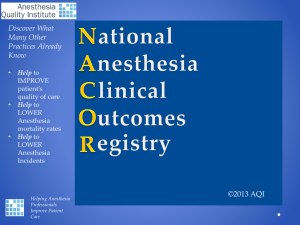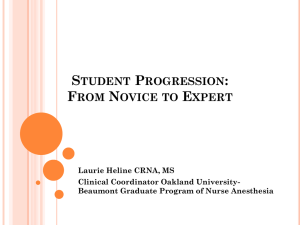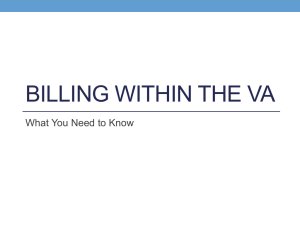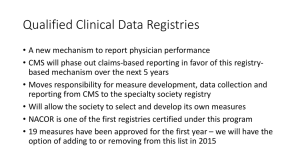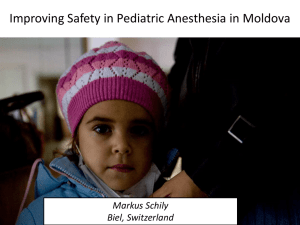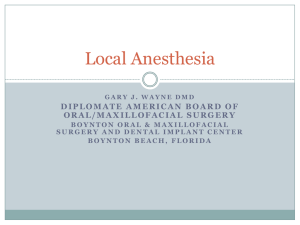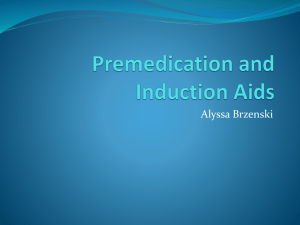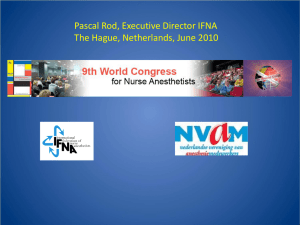Anesthesia Mishaps - Maryland Association of Nurse Anesthetists
advertisement
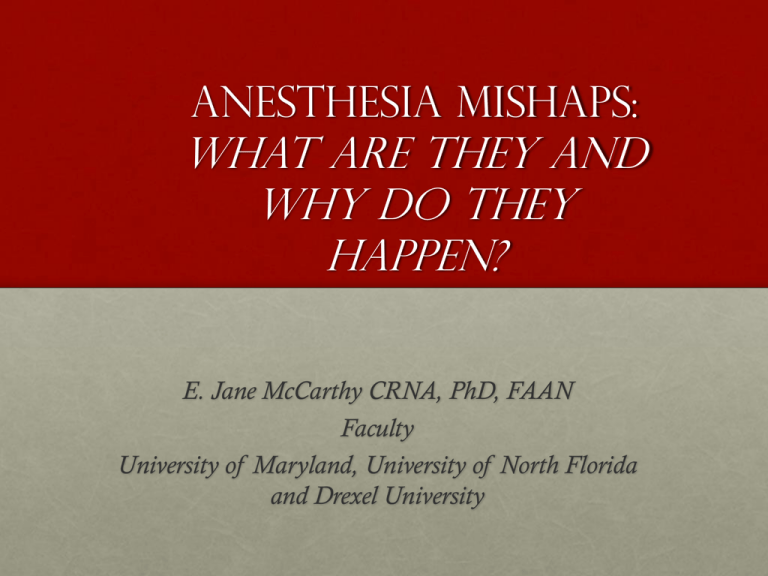
Anesthesia Mishaps: What are they and why do they happen? E. Jane McCarthy CRNA, PhD, FAAN Faculty University of Maryland, University of North Florida and Drexel University Learning Objectives • Discuss the history of the safety of anesthesia. • Define anesthesia mishap, critical incident and critical event. • List common causes of anesthesia mishaps. • Discuss effectiveness of monitors in preventing anesthesia mishaps. • List steps taken in anesthesia clinical practice that prevent anesthesia mishaps. • Discuss human factors influencing patient safety. • Discuss results of studies of anesthesia providers on patient outcomes. • Present a case study pertaining to anesthesia mishaps. • Discuss resources available to address adverse event experiences. IOM Report: To Err is Human Nov 1, 1999 the Institute of Medicine report stated: • “Healthcare in the US is not as safe as it should be and can be.” • “At least 44,000 people and perhaps as many as 98,000 people die in hospitals each year as a result of medical errors that could have been prevented.” History of Anesthesia Mortality • First anesthetic death recorded Jan 28, 1848, three months after the first public demonstration of ether anesthesia by Morton. • “Anesthesia is an area in which very impressive improvements in safety have been made.” • 1980s - 2 deaths per 10,000 anesthetics administered. • Today - 1 death per 200,000 to 300,000 anesthetics administered. • Causes for Improvement • improved monitoring techniques • widespread adoption of practice guidelines • other systematic approaches to reducing errors To Err is Human. IOM Report, 1999 A Critical Incident A human error or equipment failure which, if not detected and corrected in time, could cause morbidity or mortality. An event that causes or has the potential to cause injury if not noticed or corrected in a timely manner. Cooper, JB, Anesthesiology, 1984 Critical Incidents • Breathing system disconnect • Esophageal intubation • Laryngoscope malfunction • Loss of oxygen supply • Vaporizer left on • Syringe swap or mislabel Adverse Event • An injury to a patient caused by their medical care rather than their underlying disease • An undesirable clinical outcome resulting from diagnosis or treatment: • Pneumothorax from central venous catheter placement • Anaphylactic reaction to a drug • Unintended laceration/perforation • Sentinel Event • An event that results in unanticipated death or serious injury to a patient and is not related to the natural course of a patient’s illness. For example: • Permanent loss of function unrelated to the course of illness • Surgery on the wrong side or wrong patient • Hemolytic reactions related to the administration of wrong blood to patient. Anesthesia Mishap A critical incident that could have led if not discovered or corrected in time or did lead to an undesirable outcome (increased hospital stay, disability or death). Cooper JB, et a; Qual Saf Health Care, 2002 Anesthesia Mishap Esophageal intubation Ventilator disconnect Loss of O2 Supply Inadequate ventilation Anesthesia Disaster Anoxia Cardiac Arrest Anesthesia Outcomes Brain Death Death Recovery with no damage Monitors Vigilance Classic Paper: Preventable anesthesia mishaps – a study of human factors • The author J Cooper, a biomedical engineer at Mass General Hospital Anesthesia Dept. published this critical incident analysis in 1978 to uncover patterns of frequent anesthesia mishaps. • He identified 359 preventable incidents by interviewing MDAs and residents at MGH. • He found 82% involved human error due to: • • • • Inadequate experience Unfamiliarity with equipment Inadequate communication Haste and distraction J Cooper, 1978 Mishaps and human factors “Anesthesia seems to be an area where outcome is only minimally affected by medical knowledge but greatly affect by factors such as: - attention - concentration - organization - ability to function as part of a team.” Blumenreich, AANA Journal, 1986 The most frequent incidents* Breathing circuit disconnection 27 Inadvertent gas flow change† 22 Syringe swap 19 Gas supply problem 15 Intravenous apparatus disconnection 11 Laryngoscope malfunction 11 Premature extubation 10 Breathing circuit connection error 9 Hypovolemia 9 Tracheal airway device position changes 7 *This list includes both human error and equipment failures. These categories encompass only 39% of the total with the remainder representing a larger variety. Cooper, 1978 Distribution of incidents during anesthetic Pre-induction During induction Beginning of procedure Middle of procedure End of procedure After procedure Total incidents 4% (10) 26% (72) 17% (48) 42% (115) 9% (24) 3% (8) = 277 Cooper 1978 Etiology: Factors leading to an Anesthesia Mishap Lack of monitors Fatigue Human error Equipment failure OR environment Lack of vigilance Lack of standards Mishaps vs. Oximetry Monitoring • Keenan (1985) looked at 163,240 anesthetics and found 27 mishaps including 11 cardiac arrests during anesthesia. • Twelve of the 27 mishaps were do to failure to ventilate resulting in hypoxemia. • Esophageal intubation • Airway disconnect • Keenan (lecture, USUHS, 1988) had at that time • Studied 25,000 cases with no mishaps with oximetry • Speculated that pulse oximetry prevents these critical incidents of failure to ventilate. Keenan, JAMA, 1985 Mishaps vs. Oximetry and Standards • Eichhorn in 1989 looked at more than 1 mil anesthetics and identified 11 anesthetic accidents from 1976-1988. • Nine of the 11 were due to failure to ventilated. • 10 accidents and five deaths occurred before monitoring standards and oximetry. • One accident and no deaths after oximetry and standards. Eichhorn, Anesthesiology, 1989 Provider vs. Mishaps “An understanding of the nature of anesthesia would lead one to expect no significant difference in quality. The vast majority of anesthesia-related accidents have nothing to do with the level of education of the provider.” Blumenreich, AANA Journal, 1986 Mishap vs. Provider • Bechtoldt (1981)did a small study looking at anesthetic deaths 1969-1976 and found no difference in provider and outcome. • Forrest (1980) looked at mortality/morbidity data from hospitals using either MDAs or CRNAs and found no differences in outcomes related to provider. • The CHER study (1986) done by HCFA reviewed three studies examining outcomes by provider and found no difference. • Pine (2003) looking at death rates of surgical Medicare patients found no difference when comparing providers CRNAs working individually or with MDAs. • Needleman study (2008) found no difference in provider for outcomes in obstetrical patients. • Simonson study (2007) found no difference in provider for outcomes in obstetrical patients. • Dulisse and Cromwell (2010) did an analysis of Medicare data for 1999-2005 found no difference in mortality between MDAs and solo practicing CRNAs. A 2014 Cocharane Review on physician anesthetist vs. non-physician anesthetist by SR Lewis, A Nicholson, AF Smith and P Alderson An analysis of six non randomized studies of 1,563,820 patients receiving anesthesia found no difference in safety and effectiveness of different anesthesia providers for patients undergoing surgical procedures with general or regional anesthesia. The Purpose of Anesthesia Monitoring • To measure the patient’s physiologic response to anesthesia. • To observe the patient’s response to other interventions. • To observe the functioning of equipment. Precordial Stethoscope • Continuous auscultation monitor • Detects ventilation breath by breath – senses apnea before hemoglobin desaturation. • Minimal cost • Minimal incidence of equipment failure • Detects airway disconnects quickly • Available for use on that desert island Anesthesia Monitoring and Standards • AANA Patient Monitoring Standards • ASA Monitoring Standards • ASTM Anesthesia Machine Standards • FDA Anesthesia Machine Check Standard • State Anesthesia Regulations AANA Monitoring Standards • Part of AANA Standards for Nurse Anesthesia Practice • They apply to general anesthesia, regional anesthesia and monitored anesthesia care. • Standards may be exceeded. • Mandatory monitors are: • A CRNA • O2 analyzer • Ventilation disconnect monitor • ETCO2 monitor • Pulse oximeter • BP/EKG • Temperature monitor for general anesthesia only • Peripheral nerve stimulator Anesthesia Mishaps Case Study Case: Unexplained Apnea A 15-year-old boy with no past medical history underwent elective right knee arthroscopy and debridement under general anesthesia. After uneventful induction of anesthesia, the surgeons requested antibiotic prophylaxis with cefazolin 1 gram, which the anesthesiology team administered. Before the first incision, 50 mcg of Fentanyl was administered. About 2 minutes later, the patient became apneic. The surgeon and CRNA assumed the patient’s apnea was due to opiate sensitivity and assisted ventilation by hand for 30 minutes. However, despite a rise in the end-tidal CO2 to 70mm Hg, spontaneous respirations did not return. What was the mishap? What’s going on here ? 26 Case : Unexplained Apnea -Because the apneic episode lasted longer than 30 minutes, the anesthesia team began to question their initial assumption that the apnea was due to opiate sensitivity. -They had obtained the cefazolin from the medication drawer of the anesthesia cart. The anesthesia team examined the drawer and found vials of cefazolin and vecuronium (a long-acting paralytic agent) in adjacent drug slots. -The vials were of the same size and shape, with similar red plastic caps. The team realized that the patient had received vecuronium 10 mg, not cefazolin 1 g, and that the observed apnea was therefore due to unrecognized muscle relaxation. 27 Medication Errors • #1 cause of adverse and preventable patient events • 7000 deaths annually • 45% of adverse drug events are caused by errors Leape LL, et al. New Eng J Med. 1991;324:377-384. IOM Report (1999)—To Err is Human. 28 Drug Administration Errors in the OR Out of 58 events related to drugs in the OR, 71% involved muscle relaxants 29 Cooper JB, et al. Anesthesiology. 1984;60:34-42. Leape LL, et al. JAMA. 1995;274:35-43. Risk Factors for Drug Errors in OR • Unfamiliar settings • New drug packaging or ampules • Similarly appearing ampules are stored close together in the drug carts • Syringes prepared by other personnel • Handwritten labels used • Poor lighting conditions • Multiple medications 30 Similar Vials: Cefazolin and Vecuronium 31 How to Prevent Wrong Drug Administration • Check for correct patient, drug name, concentration, dose, route, time • Use drug labels that conform to ASTM standards • Label syringes —use preprinted color-coded adhesive labels • For emergency drugs, use “ready-to-use” syringes prepared according to ASTM standards • Standardize location of drugs in drug cart • Discard unlabeled vials, syringes • Bar coding 32 What do we do when a sentinel event or adverse event does occur? Lynn Reede, CRNA, DNP, MBA Senior Director, Professional Practice American Association of Nurse Anesthetists lreede@aana.com /www.aana.com Patient disclosure is appropriate in the following situations: All sentinel events Adverse events and medical errors that: Result in temporary or permanent impairment of body function Require transfer to an ICU Additional surgery or other medical intervention Adverse Events – Guidelines for Disclosure to Patients Washington University School of Medicine St Louis Patient Disclosure Providing information to patients and their families about unexpected harm that occurs as a result of their medical care, not directly because of a patient’s illness or underlying disease. Adverse Events – Guidelines for Disclosure to Patients Washington University School of Medicine St Louis Patient disclosure does not include: claiming liability by saying, “I caused this problem . . .” criticism of the care or response of other providers making excuses, being misleading, defensive or mysterious altering the medical record, or placing personal notes or comments in the record relying on an ad hoc process to determine what will be communicated or who will speak for the team communicating “off the record” stating or implying causation unless causation is clear and unequivocal Adverse Events – Guidelines for Disclosure to Patients Washington University School of Medicine St Louis Model Language for Patient Disclosure Let me tell you what I know about what happened. Instead of receiving ______, we gave you ____ instead. I want to discuss what this means for your health, but first I want to tell you how sorry I am that this happened.. I’m sorry. This should not have happened…or…We made an error. I’m sorry. Right now I don’t know exactly what happened but I promise you that we’re going to find out and make sure it doesn’t happen again. It may take time to get to the bottom of it, but I’ll share with you what we find out as soon as I know. Again, let me tell you how sorry I am that this happened. Adverse Events – Guidelines for Disclosure to Patients Washington University School of Medicine St Louis Anesthesia Safety Patient Foundation- Adverse Event Protocol Anesthesia Patient Safety Foundation (APSF) “Adverse Event Protocol” Describes a plan of action for anesthesia provider at the recognition of a major adverse anesthesia event. www.apsf.org/resource_center/clinical_safety The Second Victim Who will take care of you? Disasters & Their Aftermath Not knowing where to turn Not having a readily apparent venue to openly share feeling The provider may turn inward looking for solutions Dealing with these complex and strong emotions may lead to dysfunctional behavior Psychometric Evaluation of the Perioperative Catastrophe Survey • PI: Maria van Pelt, CRNA • Co-investigators: Farnaz Gazoni, Marcel Durieux • Funded AANA Wellness Grant 2010 Original survey developed by Gazoni, Amato, Malik, Zahra & Durieux (2011) • Solicited anesthesiologists’ experiences with patient injuries and adverse events Emotional Impact of Index Case Gazoni et al (n=659) van Pelt, Gazoni, Durieux (n=196) Considered Career Change Inability to Work Loss of Confidence Defesniveness Anger Professional Self-Doubt Perceived Loss of Reputation Use of Illicit Substance Reliving the Event Fear of Judgment by Colleagues Fear of Litigation Excessive Sleepiness Sleeplessness Anxiety Depression Guilt 0 20 40 60 80 100 Study of Critical Incidents during anesthesia training • You will experience one perioperative death in your lifetime • Profoundly affected with the majority of them feeling that they required help. • Many felt that they should stop working for 24 hours. • The earlier in training, the more stressful such an event is perceived. Tan, H. Debriefing After Critical Incidents for Anesthesia Trainees. Anaesth intensive Care 2005; 33: 768-72 So, What is the AANA Doing? Critical Incidents and Adverse Events Open Forum 2013 AANA Annual Meeting Evaluation Results Lynn Reede, CRNA, DNP, MBA Survey Background Survey was administered using SurveyMonkey A total of 96 Critical Incidents/Adverse Events Open Forum attendees were invited to participate Invitations were delivered on August 29, 2013 and survey closed on September 7, 2013 17 respondents completed the survey for a response rate of 17.7%. Percentages and values are presented for each item response Survey Summary No formal debriefing process (or not aware of) in any of respondent’s facilities. > 50% not prepared to deal with critical incident. When critical incident did occur, the majority received support from AANA Open Forum or peers outside the workplace. Majority interested in topic and learning of others’ experiences. Majority felt debriefing after a critical incident is important. 100% would attend another open forum. “Two Fold Message” It is “OK” to not be “OK.” As anesthesia providers & educators we care for other’s needs and help others succeed. Be the one to take the student or colleague aside and ask: “Are you OK?” Our Voices ARE Finally Heard!! The AANA is listening. Take care please! Lynn Reede lreede@aana.com Julie Rice wellness@aana.com Maria (Magro) van Pelt mariamagro@yahoo.com AANA Wellness Program www.AANA.com/adverseevents
